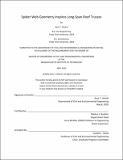| dc.contributor.advisor | Markus J. Buehler. | en_US |
| dc.contributor.author | Heckel, Ayse Y. | en_US |
| dc.contributor.other | Massachusetts Institute of Technology. Department of Civil and Environmental Engineering. | en_US |
| dc.date.accessioned | 2020-09-15T21:50:25Z | |
| dc.date.available | 2020-09-15T21:50:25Z | |
| dc.date.copyright | 2020 | en_US |
| dc.date.issued | 2020 | en_US |
| dc.identifier.uri | https://hdl.handle.net/1721.1/127288 | |
| dc.description | Thesis: M. Eng., Massachusetts Institute of Technology, Department of Civil and Environmental Engineering, May, 2020 | en_US |
| dc.description | Cataloged from the official PDF of thesis. | en_US |
| dc.description | Includes bibliographical references (pages 16-18). | en_US |
| dc.description.abstract | This research explores the methods and results used to learn from spider web geometries and implement them into a practical long span roof truss structure. Specifically, utilizing data and properties of spider webs found in research from Su et al. (Su I. a., 2016). The research uses and implements spider's web design blueprints in present day structural systems. Initially, the size of long span roof truss is determined by the finding the gravity and lateral loads applied an ordinary building structure based on the current building code. Then, the web geometry of a Crytophora citricola's, or tent web spider's web is analyzed and optimized for structural efficiency under loading. The performance of this spider-inspired truss geometry is then compared to a typical truss seen in construction today. This research demonstrates that many web geometries are optimal, or close to it, and are comparable in structural efficiency to the trusses currently used in structures. Therefore, architects and structural engineers can use building code to design irregular spider web-shaped trusses in many instances, for example, in architecturally aesthetic purposes or in reusing old structural materials. | en_US |
| dc.description.statementofresponsibility | by Ayse Y. Heckel. | en_US |
| dc.format.extent | 18 pages | en_US |
| dc.language.iso | eng | en_US |
| dc.publisher | Massachusetts Institute of Technology | en_US |
| dc.rights | MIT theses may be protected by copyright. Please reuse MIT thesis content according to the MIT Libraries Permissions Policy, which is available through the URL provided. | en_US |
| dc.rights.uri | http://dspace.mit.edu/handle/1721.1/7582 | en_US |
| dc.subject | Civil and Environmental Engineering. | en_US |
| dc.title | Spider web geometry inspires long span roof trusses | en_US |
| dc.type | Thesis | en_US |
| dc.description.degree | M. Eng. | en_US |
| dc.contributor.department | Massachusetts Institute of Technology. Department of Civil and Environmental Engineering | en_US |
| dc.identifier.oclc | 1191897265 | en_US |
| dc.description.collection | M.Eng. Massachusetts Institute of Technology, Department of Civil and Environmental Engineering | en_US |
| dspace.imported | 2020-09-15T21:50:24Z | en_US |
| mit.thesis.degree | Master | en_US |
| mit.thesis.department | CivEng | en_US |
